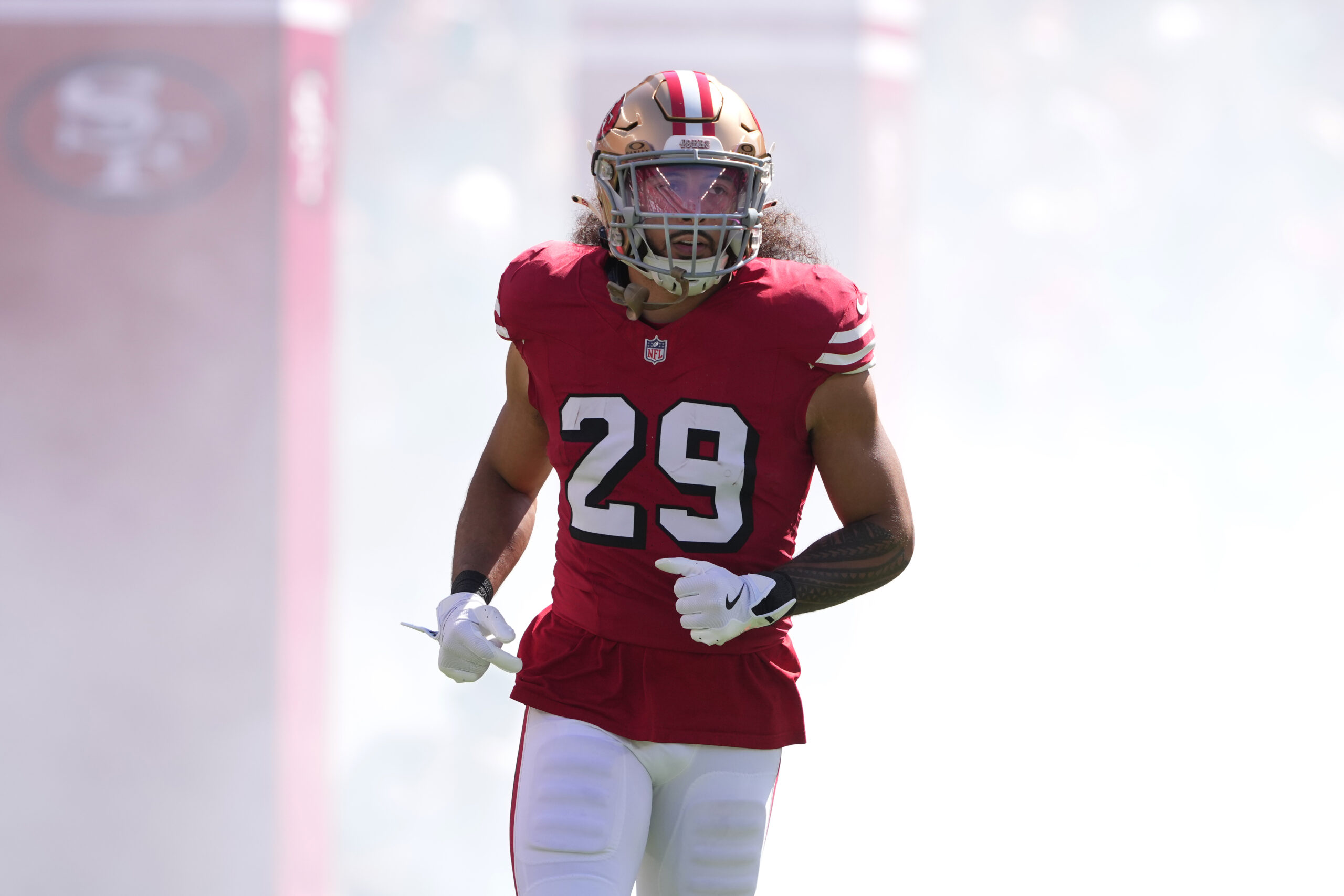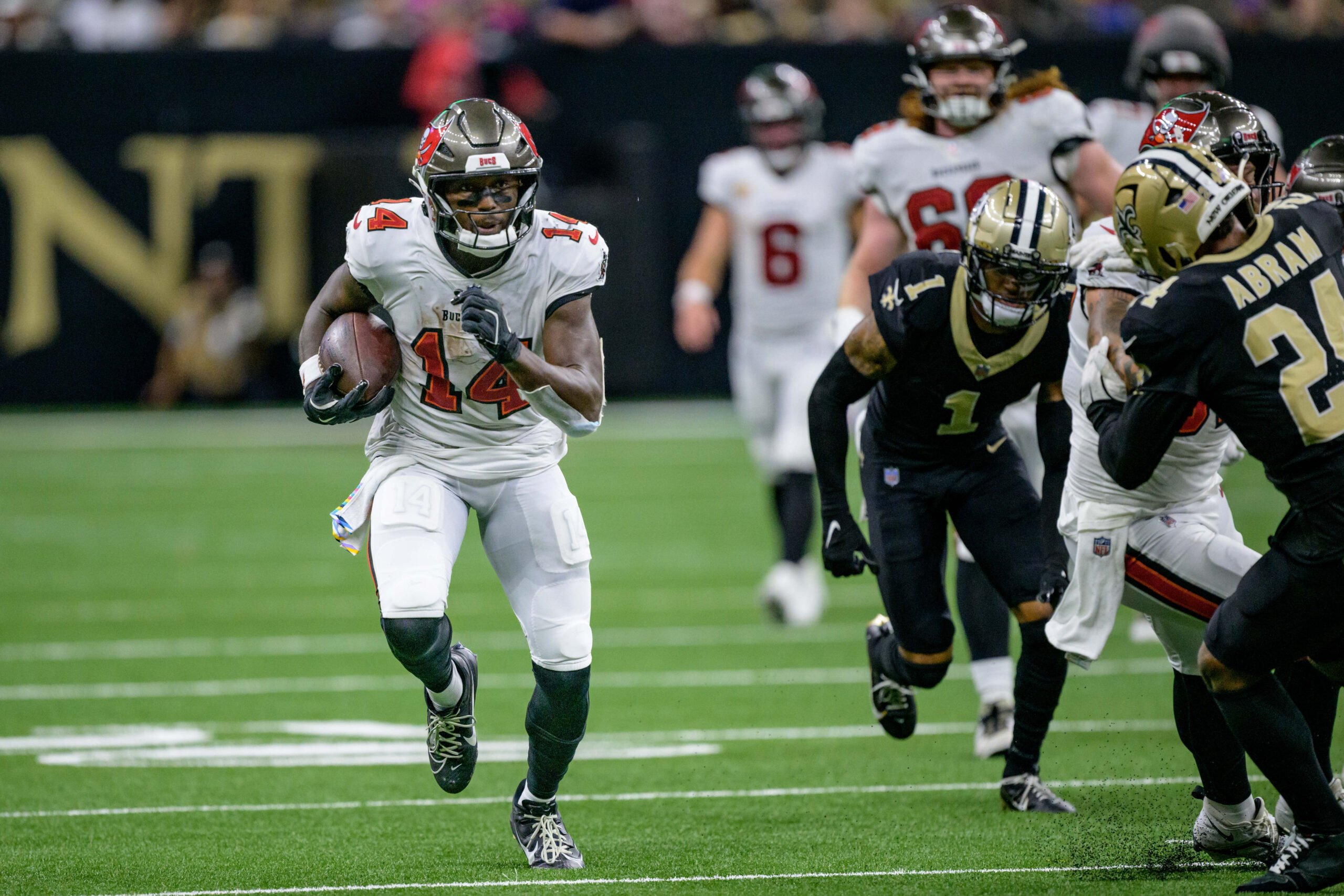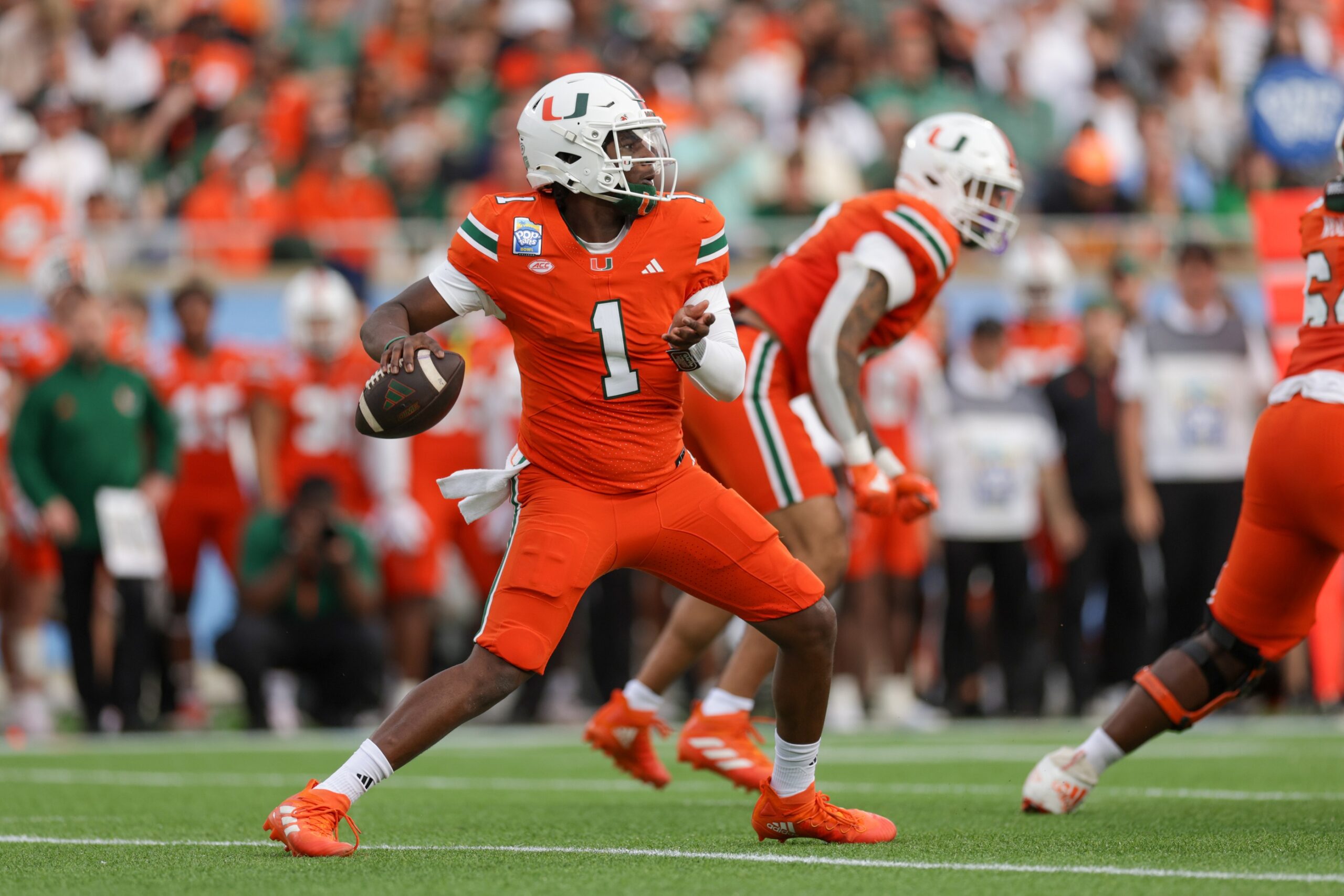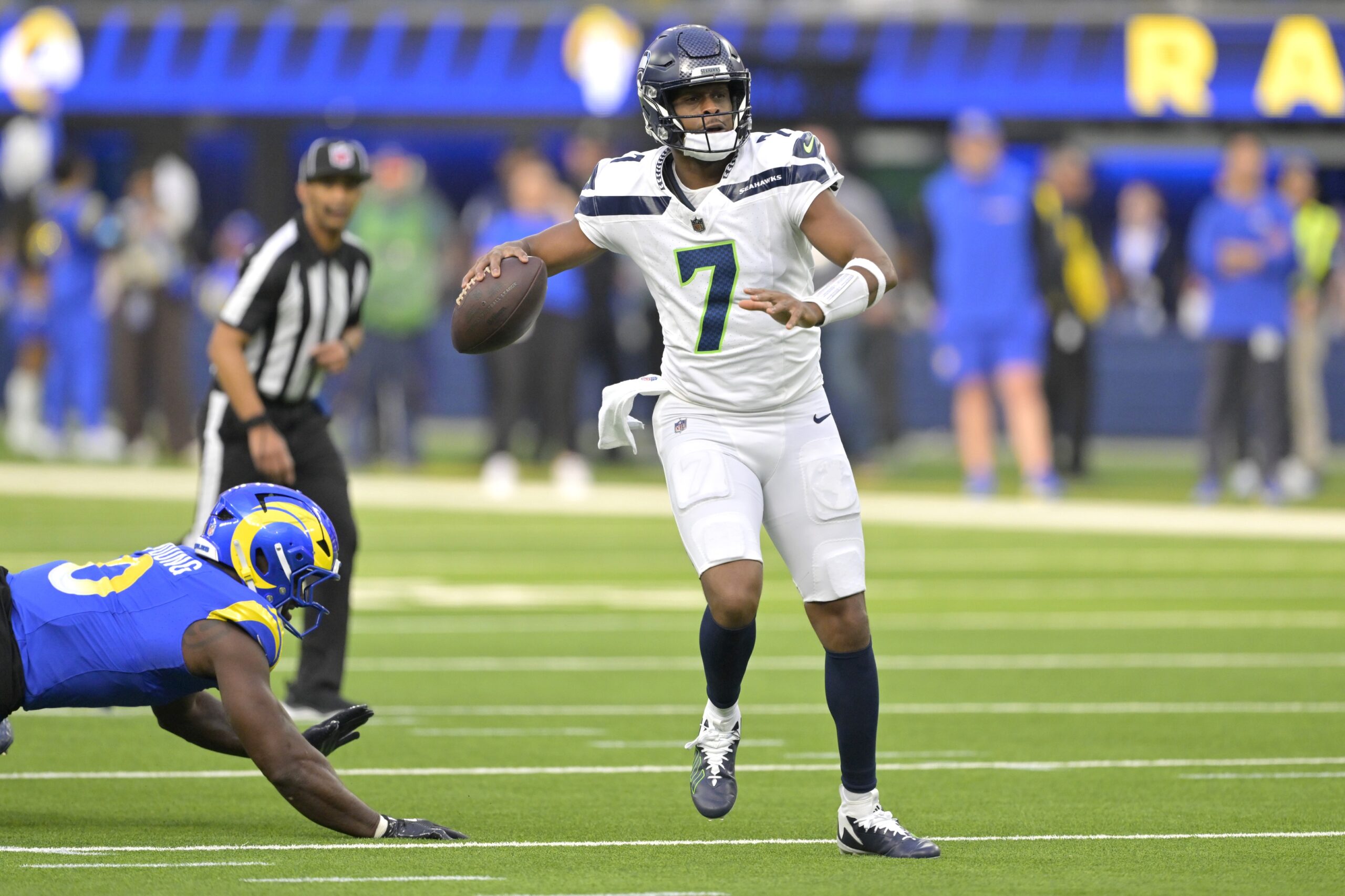NFL Analysis
12/9/24
24 min read
1st & 10 Week 14: Stafford vs Allen, Darnold's Big Day, Another Chiefs Win & More
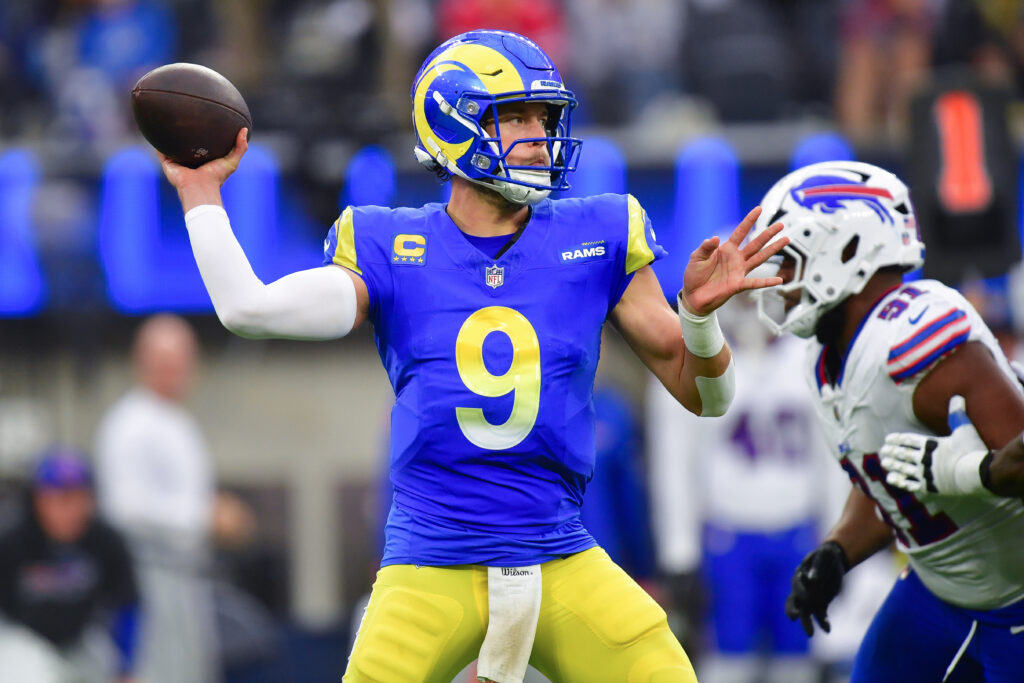
NFL Week 14 was full of byes and gave us a slow start but picked up at the end. We have just four weeks remaining in the regular season, and the playoff picture is coming into form.
Each week, 1st & 10 will bring you a Monday morning an in-depth breakdown of everything you need to know from Sunday’s slate of games. We’ll fill this column with stats, film, and plenty of words to keep you covered on anything you might have missed or want to dive deeper into from Sunday.
All stats provided by TruMedia unless noted otherwise
1st & 10 NFL Week 14
1. Rams-Bills A Game of the Year Candidate because the Quarterbacks Were Awesome
I won’t do my original plan, but IT WAS TOUGH.
Few things are more fun in football than when a great quarterback is on an absolute heater. We got two of those in the Rams’ 44-22 win against the Bills. These teams combined for 902 yards of offense. The Bills averaged 8.2 yards per play, their sixth over the past five years and the most in the league during that span.
Let’s just quickly dive into what these quarterbacks did: Matthew Stafford had 0.89 EPA per play with a 63.3 percent success rate. He averaged 10.7 yards per attempt while completing 76.7 percent of his passes on a 9.3-yard average depth of target. Josh Allen averaged 0.65 EPA per play with a 53.2 percent success rate, averaging 9.2 yards per attempt to go along with three rushing touchdowns. Both quarterbacks had a QBR above 90.
When the Rams play at this level, few teams can hang with them. The problem is we haven’t consistently gotten this version of the Rams. Through injuries and inconsistent play, the Rams have not been a fully functional unit for much of the season.
This was a vintage Stafford performance, pushing the ball and fitting passes into tight windows. Buffalo played a lot of zone coverage to start this game, which Stafford has picked apart this season — he came into the game 12th in EPA per play against zone and 20th against man — but he was making the types of throws that it wouldn’t have mattered what kind of coverage the defense was running out.
His throw to the sideline off play-action to Puka Nacua in the second quarter could not have been better placed.
He had another sideline throw to Nacua early in the third quarter from empty while fading away from potential pressure.
The Rams went back to the version of the offense run during Stafford’s first seasons with the team. This was the first game of the season the Rams did not play a single snap in pistol, even though that became a big part of the offense from the second half of last season into this year. Instead, Stafford played empty on 23.3 percent of his snaps.
When Stafford first came to the Rams, they relied heavily on empty formations and Stafford’s ability to throw deep from them. No offense was more vertical while playing so often in empty. But that faded from the offense as there has not been as much confidence in the offensive line to hold up in empty protection and give Stafford enough time to push the ball down the field.
He’s only used empty more than 10 percent of the time in three other games this season and no higher than 14.3 percent back in Week 3. Stafford had not been in empty on more than 20 percent of his dropbacks since Week 8 of last season (33.3 percent) before the Rams made their second-half changes on offense.
While in empty, Stafford went 7-of-7 for 97 yards and two touchdowns, good for 2.50 EPA per play.
Stafford shortly followed up that throw to Nacua with a perfectly placed ball to Cooper Kupp down the seam.
The Rams picked apart the Bills in the intermediate level of the field, between 11 and 19 air yards. Stafford threw 43.3 percent of his passes to that area and went 10-of-13 for 172 yards and a touchdown. This was one place where the Rams created some openings against Buffalo’s zone coverage.
On a third-and-6 in the third quarter, the Rams motioned Nacua across the formation into a bunch on the right side of the formation. With no one following the motion, the Rams got the zone coverage indicator. They then ran a hi-lo with Kupp and Nacua while Tuttu Atwell went vertical to carry the cornerback. That created space for Nacua on a corner route and a gain of 21 yards.
— Dan Pizzuta (@DanPizzuta) December 9, 2024
That helped set up this touchdown throw to Kupp from empty on a third-and-3.
This was one of the best quarterbacking performances we’ve seen over the past 25 seasons, especially at this volume.
Since 2000, Stafford’s 0.89 EPA per play is the seventh-best for a game with at least 30 pass attempts.
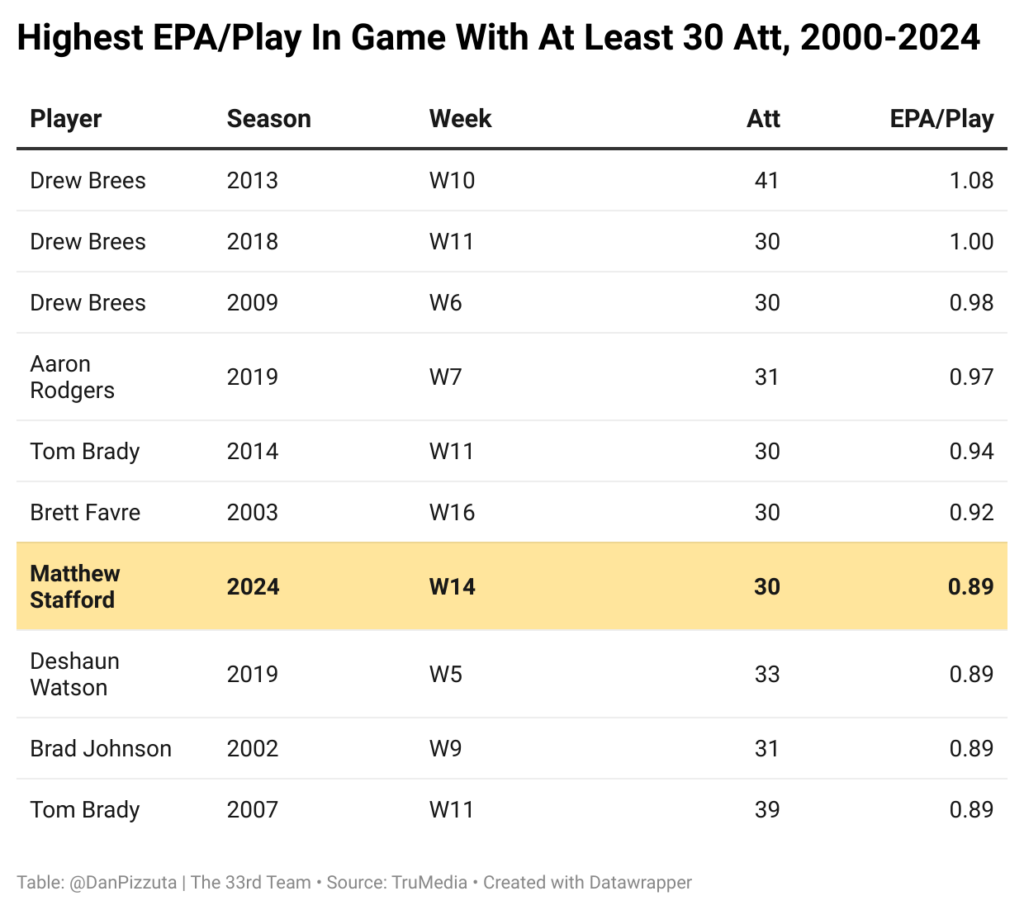
For as good as Stafford was, Allen hung with him. While this was a vintage performance from Stafford in a positive sense, it was a vintage Allen performance in a way that shines slightly negatively on the Bills as a team. Allen was asked to do everything like he did in earlier years of his career.
Allen led the team with 82 rushing yards. The next-highest rusher was James Cook, who had six carries for 20 yards. After the game, Sean McDermott said he wished the Bills could have run the ball better. That might seem like a wild thing to say after his offense put up 42 points, but he has a point — the shift for the Bills has been how they’ve run a balanced offense and have multiple avenues for efficiency instead of asking the quarterback to play god. But Allen came close.
In this game, Allen became the first player to throw for three touchdowns and rush for three. That’s a week after he joined a small group of players with a passing, rushing, and receiving touchdown in the same game. He also joined Lamar Jackson at the top of the EPA per-play leaderboard for the season at 0.26. Allen might have made his best MVP case in a losing effort.
It’s a testament to Allen that we’re even talking about this as a close game because the Bills were down 31-14 late in the third quarter.
Allen made a 17-yard scramble on a second-and-25.
On the next play, he found Khalil Shakir, who ran through the Rams’ defense for a 51-yard touchdown.
On the next drive, Allen found Shakir deep for a 34-yard gain that set up an Allen rushing touchdown. Shakir is now 10th in yards per route run on the season (2.41).
After a Rams punt, Allen had a perfectly placed touchdown throw to Mack Hollins.
A few coaching decisions mattered at the end of this game. With 4:47 remaining, the Rams had a 38-35 lead and faced a third-and-7 at the Buffalo 37-yard line. Stafford scrambled for a yard, but there was a holding on the play. Buffalo accepted the penalty and elected to give the Rams a third-and-16. The Rams gained 11 yards on third down and kept the offense on the field for a fourth-and-5.
This is the situation where kicking a field goal to go up by six points can be detrimental to the offense — a touchdown still beats you, and the opponent knows a touchdown is needed. McVay went for it on fourth-and-5, and the Rams converted for 11 yards. They scored on a 19-yard pass to Nacua three plays later for a 44–35 lead.
Given the Rams went for it on the fourth-and-5 — incredible growth for McVay, who is one of the league’s least aggressive coaches on fourth downs — it’s fair to assume they would have gone for it on an earlier fourth-and-6 had the Bills declined the penalty, making that decision less likely to matter, though the extra 40 seconds from the penalty to the eventual conversion did hurt.
On the next drive, the Bills got down to the 1-yard line with 1:06 remaining and all three timeouts remaining. The Bills tried to run a sneak, but Allen was stopped short. Instead of trying to regroup with the clock running and the ball still at the 1, the Bills called their first timeout — essentially guaranteeing the need for an onside kick since the Bills could not stop the clock after each down when the Rams got possession.
Buffalo scored on the next play but did not recover the onside kick and did not get the ball back. This costly error will likely keep the Bills from having a shot at the top seed in the AFC. Per The Upshot, Buffalo has a 23 percent chance for the bye, needing Kansas City to now lose twice in the next four games.
The Rams, meanwhile, stay alive in the playoff hunt with a 36 percent chance to make the playoffs. Their path is to win the division, and they have games against the 49ers, Jets, Cardinals, and Seahawks to end the year.
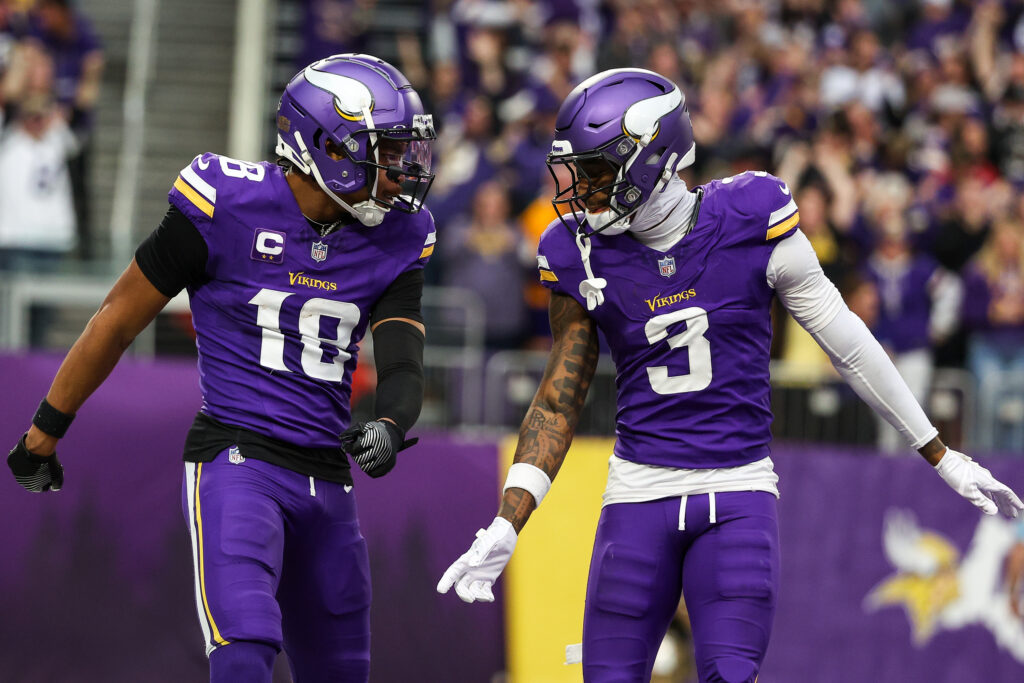
2. Vikings' offensive explosion
Early on Sunday morning, the insider scoop was that the Vikings and Sam Darnold had not discussed a long-term contract. A few hours later, Darnold had his best game of the season.
Darnold went full aerial assault against the Falcons. He had a 10.4-yard average depth of target, 10.8-yard average depth of completion, and averaged 12.4 yards per attempt for 0.71 EPA per play.
This game, one that featured Minnesota’s old quarterback, highlighted how the current quarterback and offensive system work perfectly for each other. Darnold hasn’t been a completely changed quarterback this season. We’ve still seen some of the risky throws and bad decisions, but more often than not, the good plays and the open opportunities in the offense have been more meaningful than the bad ones.
Darnold’s willingness to let it rip works for an offense that has Justin Jefferson and Jordan Addison.
His first of five touchdowns on the day was a 49-yard pass to Addison. On the play, Darnold faces pressure and doesn’t get everything on the pass, but Addison has become one of the league’s best ball trackers — especially on these deep throws — and stops his route to turn around and make the catch, leaving cornerback Mike Hughes well behind him.
On the next touchdown, the Vikings were just outside the 10-yard line. They came out in a bunch with Jefferson, Addison, and T.J. Hockenson. Jefferson motioned in, then back out and got a man coverage indicator, with Dee Alford following the motion.
Jefferson against Alford in man coverage is a favorable matchup every time, so Darnold waited for the window to open and threw a strike.
— Dan Pizzuta (@DanPizzuta) December 9, 2024
That was Jefferson’s first touchdown since Week 3. Because of how defenses have played him, Jefferson has often taken a lot of attention, and the Vikings have used that to open up more plays for others. But against the Falcons, Jefferson caught all seven of his targets for 132 yards and two touchdowns.
On his second touchdown, the Vikings motioned Jefferson across the formation to a bunch with Addison and Jalen Nailor. No one went with him, so the Vikings know it’s zone. Darnold ran around to avoid multiple defenders and threw to a wide-open Jefferson for a 52-yard touchdown.
No one went with Jefferson down the field. If Darnold had been able to stay to the left, he probably had an open throw to Addison too.
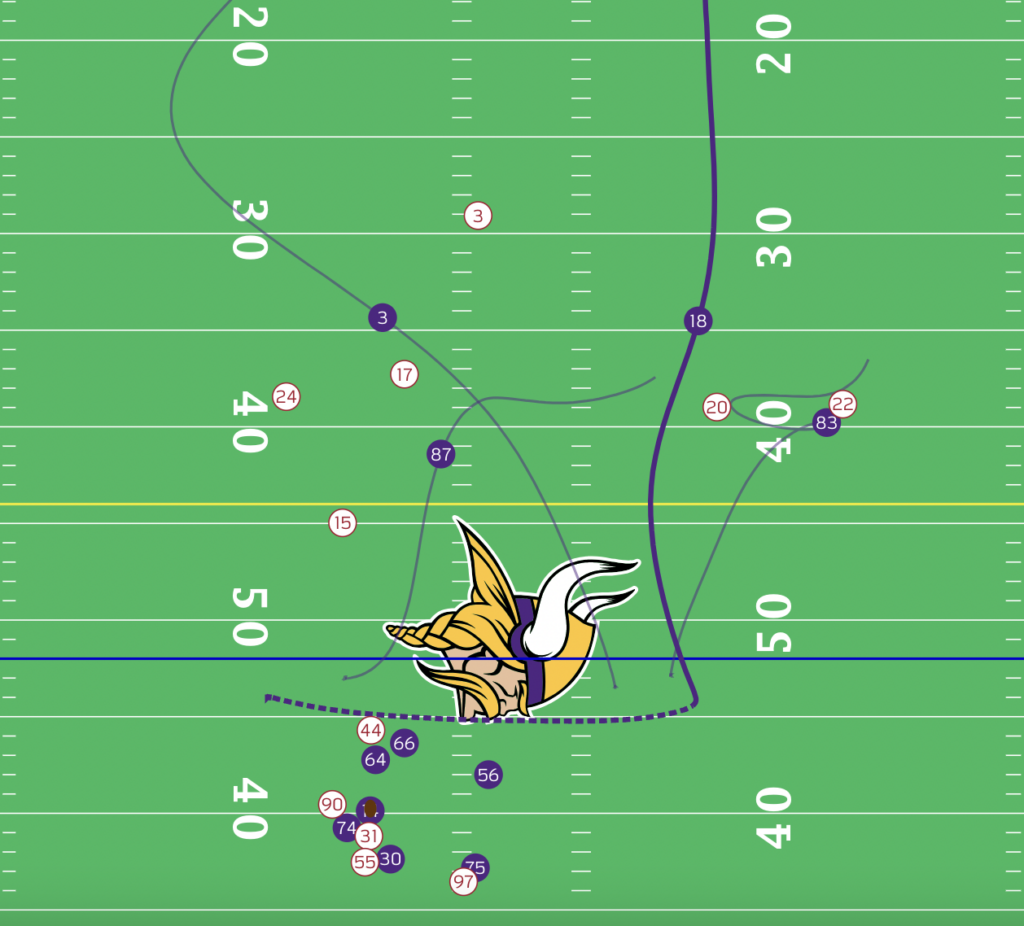
Darnold has now completed 55.6 percent of his deep passes on the season. Should that rate hold, it would be the second-highest completion rate on throws of 20 or more air yards for a full season behind a 58.3 percent mark from Drew Brees in 2006.
For now, it’s the fourth-highest since 2000 through Week 14, with at least 50 such attempts.
Highest Comp% On Deep Passes, min. 50 attempts through Week 14 (per TruMedia)
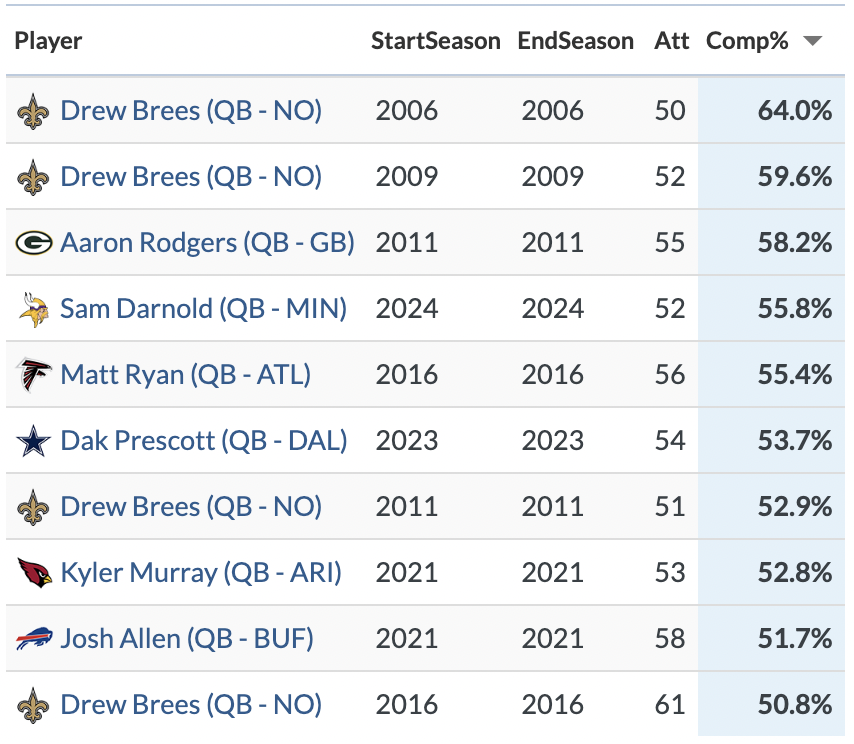
Because of how valuable quarterbacks are, Darnold could be in line for a hefty contract, maybe in the Baker Mayfield range. Still, the Vikings could also just use the franchise tag.
With J.J. McCarthy coming off an injury, it’s unclear how ready he’ll be to start the season. Darnold could be more useful for Minnesota as an insurance policy and a potential trade chip in the preseason if McCarthy is healthy.
There’s also the difficulty of figuring out what exactly Darnold is as a quarterback at the moment. He’s, of course, played better than he has in any other season of his career, but he’s also gotten a lot of help. To this point, he’s still just 16th among quarterbacks in EPA per play.
Even in this game, he was sacked on 30 percent of his pressures. However, the good has still outweighed the bad, and when the offense is clicking and the defense is doing so as well—they picked on an immobile Kirk Cousins—the Vikings look like one of the best teams in the NFC.
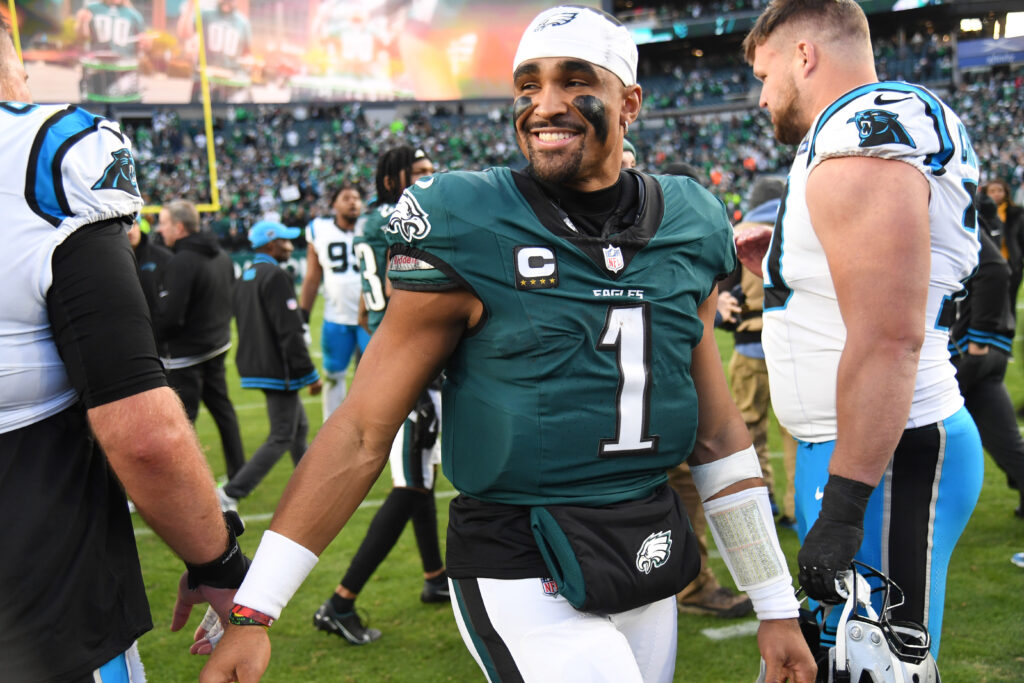
3. Eagles survive Panthers
If not for a Xavier Legette drop for a would-be touchdown, the Carolina Panthers could have beaten the Philadelphia Eagles in what would have been one of the biggest upsets of the season. Instead, the Eagles survived with a 22-16 win.
This was an uneven game in multiple aspects for the Eagles. On defense, Philadelphia had turned into one of the league’s best-passing units but allowed Adam Thielen to catch nine passes for 102 yards on 11 targets. He was Bryce Young’s go-to receiver, and whenever the Panthers needed a big play, Young found him.
The overall numbers for Young don’t look too impressive. He went 19-of-34 for 5.6 yards per attempt with a touchdown and an interception, and he still averaged -0.02 EPA per play. But he had an 85.8 QBR, which suggests a team with Young’s level of play would be expected to win 85 percent of the time.
Young had another impressive performance on tape. He extended plays with an average of 3.06 seconds to throw, and despite being pressured on 44.6 percent of his dropbacks, he only took one sack. That continues his incredible streak of being one of the best pocket managers since his return. Since Week 8, he’s been sacked on 8.7 percent of pressures, which is the fourth-lowest rate in the league.
He’s routinely been able to escape pressure and keep his eyes downfield.
His confidence in the pocket and where to go with the ball has skyrocketed.
Yet, the Panthers haven’t pulled these games out at the end. That could be beneficial while Young improves and Carolina still gets a shot at a high draft pick, but given the state of this franchise during the past few seasons, getting one of these wins would be nice.
Meanwhile, the Eagles had a rough day offensively. Saquon Barkley did his thing and finished with 124 yards on 20 carries while setting the Eagles’ single-season rushing record in the process. But the passing game was rough. Jalen Hurts had his lowest success rate of the season, just 39.4 percent.
He combined his longest time to throw (3.46 seconds) with his lowest aDOT of the season (6.2). The Panthers blitzed Hurts on 50 percent of his dropbacks (a week after the Ravens did not blitz at all), and Hurts looked like the quarterback who had no answers against the extra rushers.
His day ended up fine because of two passing touchdowns and a score on the ground, getting his EPA per play to 0.22, the eighth-best mark of the week.
The Eagles did not look like a team close to the No. 1 seed in the NFC, even though they looked as if they might have been the best team in the league just a week ago.

4. The Chiefs Win Close Again
With a 19-17 win over the Los Angeles Chargers, the Kansas City Chiefs tied the 1978 Houston Oilers for the most wins in a season of seven points or fewer with 10. There are still four games to go in Kansas City’s season.
This followed the script of most Chiefs games this season. The offense wasn’t explosive, but it had a 49.3 percent success rate, which was the third-highest of the week.
The Chiefs' biggest concern has become pass protection. Mahomes was hit 12 times in this game, which is tied for his second-most in a game in his career done two other times. One of those times was last week against the Raiders.
It was a problem even when he was getting the ball off.
Mahomes has now been hit at least seven times in each of the past six games. In that span, Mahomes has been hit more than any other quarterback, with 54 hits, four more than the next quarterback. Yet, Mahomes is still 11th in EPA per play during that time.
With the issues in protection, defenses are starting to get more aggressive in blitzing Mahomes. There has been some success in doing so…
Mahomes was the captain of the Do Not Blitz list, but he’s been blitzed on at least 20 percent of his dropbacks in each of his past five games. For reference, two teams that know him well, the Ravens and Chargers, blitzed him a total of six times combined in the first two weeks of the season.
He averaged 0.29 EPA per play against the Chargers’ blitz on Sunday night, but those hits still add up. He was sacked and took two other hits against the blitz. On the season, he’s averaged 0.14 EPA per play against extra rushers, which ranks 14th.
But whatever defenses try to do during the majority of the game, there’s still Mahomes doing things at the end of it.
Kansas City’s final drive took up 4:35 while the Chiefs trailed by one. At the two-minute warning, Mahomes found Travis Kelce for a nine-yard gain on third-and-7 after making a defender miss.
That set up a 31-yard field goal attempt for Matthew Wright, which won the game and clinched the AFC West. The Upshot gives the Chiefs a 70 percent chance for a bye in the AFC.
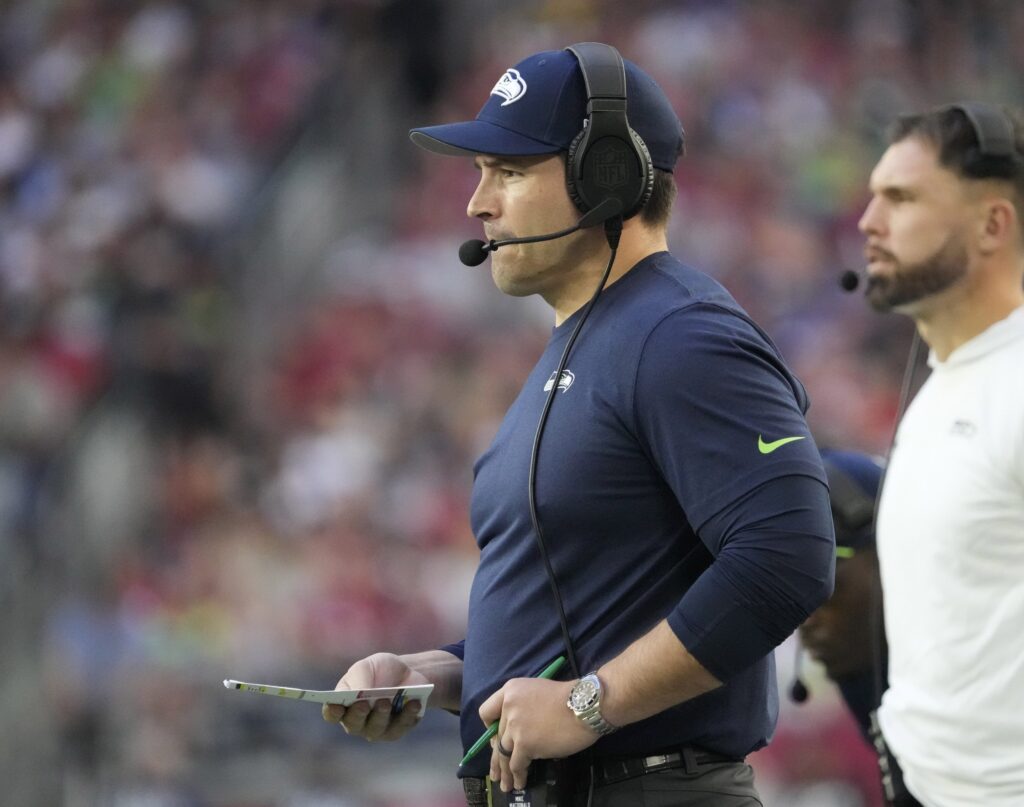
5. Seahawks Have a Defense
There’s been a switch in Seattle with a defense that is finally clicking under first-year head coach Mike Macdonald. There was a turn made around midseason, and the acquisition of linebacker Ernest Jones boosted it.

The passing stats are interesting. A higher aDOT by more than a yard might look bad, but it's partly because there aren't as many throws going up the middle.
Instead, teams are testing the Seahawks deeper outside the numbers, and that's part of why the interception numbers are up. There have been more incomplete passes down the right sideline specifically.
Seattle Opponent Pass Map Before/After Ernest Jones Trade (per TruMedia)
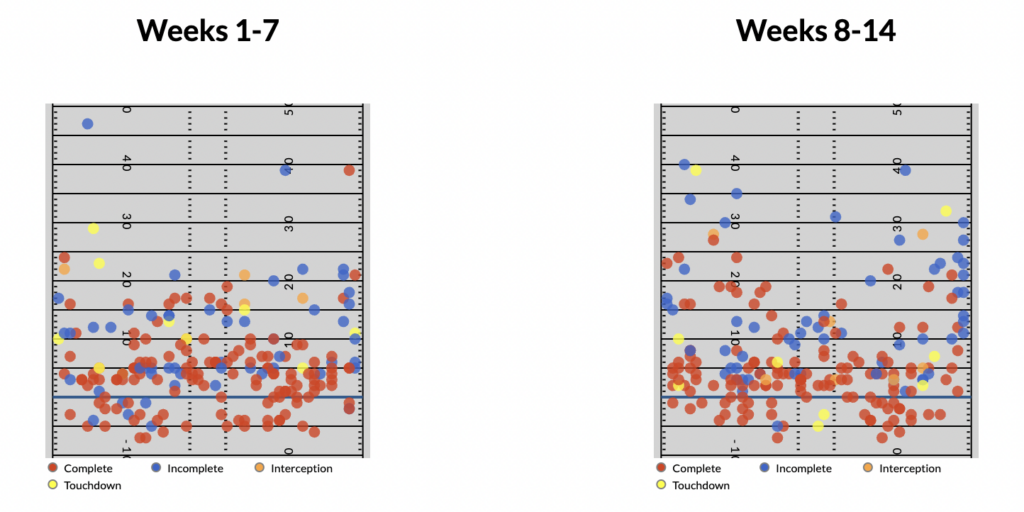
With a linebacker in place who could carry the responsibilities in coverage and against the run — Jones had eight tackles and an interception against Arizona — that’s freed up more players in the defense to move around the field and be aggressive.
Seattle has played lighter with an increase in dime usage, but it's been more stout against the run. That’s the perfect mix and was on display against Arizona. The Seahawks played two-thirds of their plays in nickel and 19 percent in dime.
Because of an early lead from the Seahawks, the Cardinals couldn't control the game in their heavy personnel packages. Arizona averaged 0.10 EPA per play in 12 personnel but played it on only 15.9 percent of plays, their lowest of the season and only game this year below 20 percent.
The Seahawks forced Kyler Murray to his lowest aDOT of the season, just 4.1 yards. He also couldn't do much as a scrambler, with only three rushes for 16 yards and no designed rushing attempts.
Seattle has leaned into creating confusion all over the defense. It started early against the Cardinals on the second play of the game after Arizona gained 11 on their opening play. The Seahawks had a four-man front but walked a linebacker down to the edge late, which changed the protection. The tackle didn’t adjust and went inside, which left Derrick Hall unblocked for a hit on Murray.
— Dan Pizzuta (@DanPizzuta) December 9, 2024
That started to force Murray into bad decisions. Arizona’s first drive resulted in a touchdown, but the next two ended with an interception. On the first, Murray never saw Jones dropping and threw the pass right to him with Marvin Harrison Jr. breaking in behind him.
On the next drive, Murray had to step up against pressure, and Coby Bryant jumped in front of a pass intended for Zay Jones.
This game was huge for the odds of winning the NFC West. With the win, the Seahawks have a 61 percent chance to make the playoffs. The Cardinals, who looked to be in control of the division, are nearly eliminated with a five percent chance at 6-7 while needing to leap both the Seahawks and Rams in the standings.
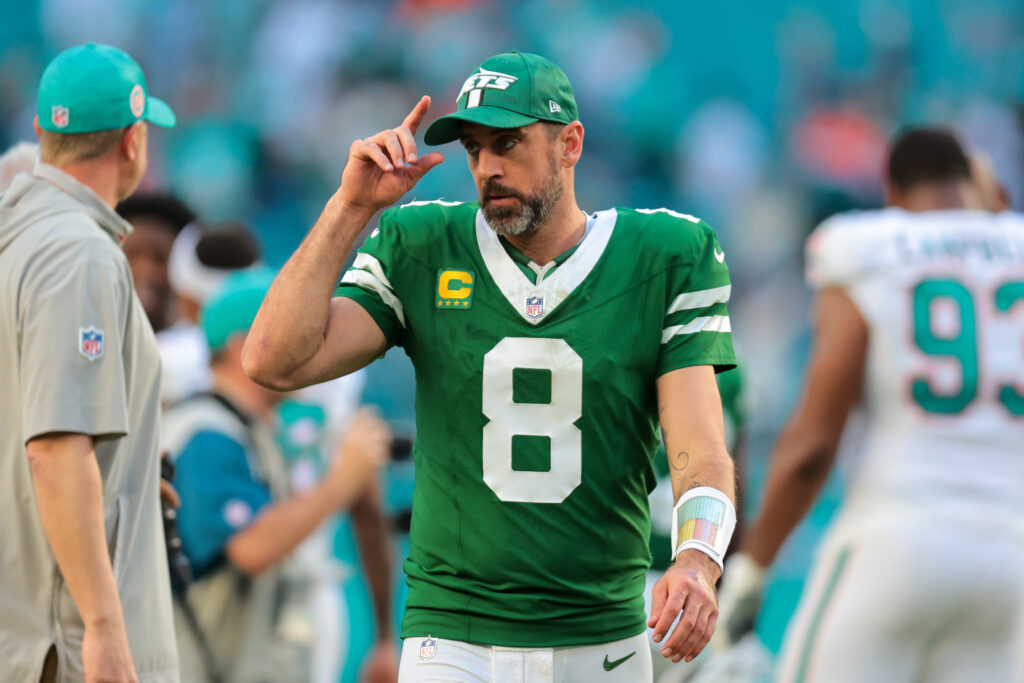
6. The Jets coached themselves out of a win
Aaron Rodgers threw for 300 yards for the first time since 2021, but the New York Jets mismanaged the game, costing themselves a win.
Both defenses struggled. Rodgers averaged 0.29 EPA per play with a 52.4 percent success rate. The Dolphins blew coverages all over the field. Tua Tagovailoa averaged 0.32 EPA per play with a 64.6 percent success rate.
In a tie game, the Jets had a first-and-10 at the Miami 27-yard line with 1:14 remaining. Per Next Gen Stats, the Jets had an 80 percent win probability at this moment. On first down, the Jets called a run, a misdirection pitch from a split-back set, which lost five yards. Miami called its second timeout to stop the clock.
On second down, the Jets called a pass, and Rodgers was sacked for a loss of six. Miami called its final timeout for third-and-21. Then, on third down, the Jets threw a pass to Davante Adams on the sideline, who went out of bounds to stop the clock.
Instead of having a chance to kick a game-winning field goal with no time left, the Jets kicked with 52 seconds remaining.
Miami got into field goal range in six plays and 45 seconds to kick a game-tying 52-yard field goal with seven seconds left. The game went into overtime; Miami got the ball first and drove 70 yards in eight plays for a touchdown, while the Jets did not touch the ball.
The Jets were officially eliminated from the playoffs, their 14th-straight season of not playing in the postseason.

7. Bucs Keep Figuring Out Offense
Baker Mayfield was not particularly good against the Raiders but still produced 0.18 EPA per play in a 28-13 win. Mayfield had a wild stat line, 10.2 yards per attempt on 29 passes, while he took four sacks with a lost fumble and threw two picks.
His QBR of 43.1 suggests his team would lose more than half the time with his play.
But the Tampa Bay Buccaneers have more built-in guardrails to keep the offense successful. The screen game is still deadly, and a rotating group of running backs has been efficient in this offense. Bucky Irving came into this game with an injury and left in the second quarter. In his absence, Rachaad White ran 17 times for 90 yards and a touchdown.
With Atlanta’s loss, Tampa Bay is now the favorite in the NFC South.
8. Chart of the day
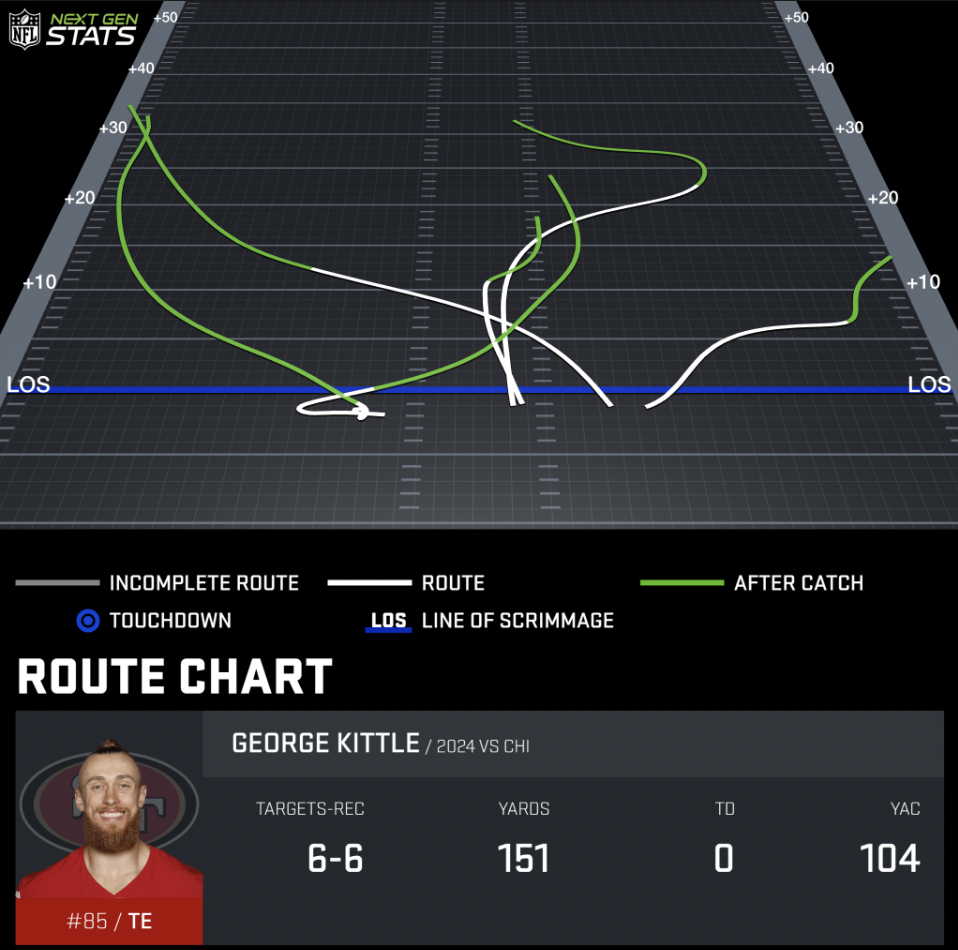
It was clear that firing Matt Eberflus was needed for the locker room and because of his handling of late-game situations, but it was clear the defense took a hit without him.
San Francisco did pretty much whatever it wanted on offense. Brock Purdy averaged 0.76 EPA per play. But we’ll focus on George Kittle’s day. The Bears came into Sunday ranked 11th in DVOA against tight ends.
Kittle had plenty of open space, running wherever he wanted to, catching all six of his targets with 104 yards after the catch.
9. Play of the day
This wasn’t the best play of the day, but it was meaningful for how the Pittsburgh Steelers played. Without George Pickens in the lineup — inactive because of a hamstring injury — Pittsburgh needed to figure out what else it had on offense.
Russell Wilson spent most of this game trying to get the ball out quickly. 65.4 percent of his attempts came within 2.5 seconds of the snap, his highest rate as a Steeler. That came with moderate success (0.08 EPA per play), but there was still a need to create some big plays down the field.
Different from most of his big plays throughout his career, this throw was down the middle of the field. He’s been good there for Pittsburgh, completing all of his deep throws between the numbers this season, but this was just his fifth attempt of the year.
Wilson went deep five times and completed three, including a back-shoulder to Mike Williams down the sideline. That 60 percent completion rate is a great figure without Pickens on the field, and Wilson has now completed an insane 51.5 percent of his attempts of 20 or more air yards this season.
10. Top of the draft check-in
With teams officially getting eliminated from the playoffs, it’s the start of draft season for some franchises. Let’s take a quick look at where we are with the current draft order.
The Raiders and Giants are 2-11 and have the first and second overall picks. Because of the projected strength of schedule, the Raiders are in the top spot, but because they have weaker opponents, they could also be more likely to sneak out a win — though that might be more difficult with Desmond Ridder slated to start after Aidan O’Connell was carted off with a knee injury that is not expected to be good.
Las Vegas finishes with games against the Falcons, Jaguars, Saints, and Chargers, while the Giants have the Ravens, Falcons, Colts, and Eagles.
However, this could get messier because there are six teams behind them with three wins. With a win against the Titans on Sunday, the Jaguars jumped from the top of the draft order to fifth, behind New England and Carolina.
Here’s the current top-10 per Tankathon, with the Bengals playing on Monday night.
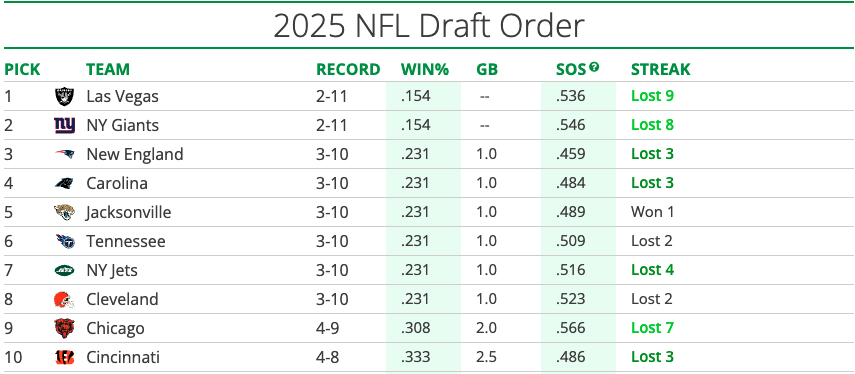
The current top two teams should be looking for a quarterback, even if those quarterbacks won’t be considered the top two players in the draft. That will leave a wide-open pool of non-quarterbacks for teams like the Patriots and Jaguars behind them.
It will be a fascinating race to the top of the order in the next four weeks.


